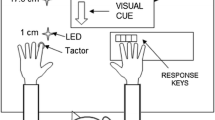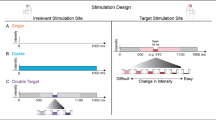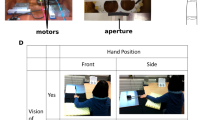Abstract
A transparent barrier, such as a window, protects us from approaching objects (such as flies), although we can still see the objects coming toward us through the occluder. In the present study, we examined whether this potential dissociation between tactile and visual experience introduced by the presence of a transparent barrier also affects visual–tactile interactions in normal participants, as indexed by performance in the crossmodal congruency task. Participants discriminated the elevation of vibrotactile target stimuli (upper vs lower) presented to the left or right hand while trying to ignore visual distractor lights that could independently be presented from upper or lower locations on either the same or the opposite side. A transparent occluder was placed between the vibrotactile targets and the visual stimuli (the barrier occluded the vibrotactile targets in Experiment 1 and the visual distractors in Experiment 2). Vibrotactile elevation discrimination performance was slower and less accurate when the distractor lights were presented from incongruent locations relative to the target (e.g., lower tactile target with upper distractor light). However, there were no significant differences between performance with and without the transparent occluder present. This pattern of results was replicated in Experiment 3 under conditions where the participants were periodically required to reach around the transparent occluder in order to press buttons placed near to the visual distractors. Taken together, these results support recent neuropsychological evidence [Farnè et al. (2003) Int J Psychophysiol 50:51–61] suggesting that visual–tactile interactions in peripersonal space are not necessarily modulated by conscious awareness of the impossibility of our hand being touched by the visual stimuli.






Similar content being viewed by others
Notes
Maravita et al. (2002b) reported a series of experiments in which the magnitude of crossmodal congruency effects were shown to be modulated as a function of whether visual distractor stimuli were seen indirectly via mirror reflection as being close to the participant’s body (although out of direct view), or else far away behind the mirror. Maravita and colleagues attributed this modulation of the crossmodal congruency effect to the fact that the distractors were situated in peripersonal space in one condition but in extrapersonal space (behind the glass) in the other. However, in the present context one might wonder to what extent this difference reflects the differential coding of visual stimuli in peripersonal as opposed to extrapersonal space, versus differences in the coding of visual distractor stimuli as a function of whether they are separated from the participant by a transparent occluder (box condition) or not (mirror condition). We will return to a fuller discussion of this issue in the “General discussion”.
Fifteen participants (five males and ten females, mean age 21 years) had to discriminate the elevation of the visual targets (upper vs lower) regardless of their side of presentation, while ignoring the vibrotactile distractor presented from one of the four possible locations. Analysis of the IE data (as per Experiment 2) revealed no main effect of occluder type [F(1,14)=2.72, p>.1] or distractor side [F(1,14)<1], nor any interaction between these factors [F(1,13)=1.56, p>.1], indicating that the transparent occluder still had no effect on performance even when participants had to concentrate on vision.
References
Austen EL, Soto-Faraco S, Pinel JPJ, Kingstone AF (2001) Virtual body effect: factors influencing visual-tactile integration. Abstracts of the Psychonomic Society 6:2
Austen EL, Soto-Faraco S, Enns JT, Kingstone A (2004) Mislocations of touch to a fake hand. Cogn Affect Behav Neurosci 4:170–181
Berti A, Frassinetti F (2000) When far becomes near: re-mapping of space by tool use. J Cogn Neurosci 12:415–420
Carlsson K, Petrovic P, Skare S, Petersson KM, Ingvar M (2000) Tickling expectations: Neural processing in anticipation of a sensory stimulus. J Cogn Neurosci 12:691-703
Farnè A, Làdavas E (2000) Dynamic size-change of hand peripersonal space following tool use. Neuroreport 11:1645–1649
Farnè A, Demattè, ML, Làdavas E (2003) Beyond the window: Multisensory representation of peripersonal space across a transparent barrier. Int J Psychophysiol 50:51–61
Holmes N, Calvert C, Spence C (2004) Extending or projecting peripersonal space with tools? Multisensory interactions highlight only the distal and proximal ends of tools. Neurosci Lett 372:62–67
Igarashi Y, Kitagawa N, Ichihara S (2004) Vision of a pictorial hand modulates visual-tactile interactions. Cogn Affect Behav Neurosci 4:182–192
Iriki A, Tanaka M, Iwamura Y (1996) Coding of modified body schema during tool use by macaque postcentral neurones. Neuroreport 7:2325–2330
Làdavas E (2002) Functional and dynamic properties of visual peripersonal space in humans. Trends Cogn Sci 6:17–22
Làdavas E, Farnè A (2004) Neuropsychological evidence for multimodal representations of space near specific body parts. In: Spence C, Driver J (eds) Crossmodal space and crossmodal attention. Oxford University Press, Oxford, pp 69–98
Maravita A, Iriki, A (2004) Tools for the body (schema). Trends Cogn Sci 8:79–86
Maravita A, Spence C, Kennett S, Driver J (2002a) Tool-use changes multimodal spatial interactions between vision and touch in normal humans. Cognition 83:B25–B34
Maravita A, Spence C, Sergent C, Driver J (2002b) Seeing your own touched hands in a mirror modulates cross-modal interactions. Psychol Sci 13:350–356
Maravita A, Spence C, Driver J (2003) Multisensory integration and the body schema: close to hand and within reach. Curr Biol 13:R531–R539
Pavani F, Castiello U (2004) Binding personal and extrapersonal space through body shadows. Nat Neurosci 7:14–16
Pavani F, Spence C, Driver J (2000) Visual capture of touch: out-of-the-body experiences with rubber gloves. Psychol Sci 11:353–359
Rorden C, Heutink J, Greenfield E, Robertson IH (1999) When a rubber hand ‘feels’ what the real hand cannot. Neuroreport 10:135–138
Soto-Faraco S, Ronald A, Spence C (in press) Tactile selective attention and body posture: assessing the multisensory contribution of vision and proprioception. Percept Psychophys
Spence C, Pavani F, Driver J (1998) What crossing the hands can reveal about crossmodal links in spatial attention. Abstracts of the Psychonomic Society 3:13
Spence C, Kingstone A, Shore DI, Gazzaniga MS (2001a) Representation of visuotactile space in the split brain. Psychol Sci 12:90–93
Spence C, Shore DI, Gazzaniga MS, Soto-Faraco S, Kingstone A (2001b) Failure to remap visuotactile space across the midline in the split-brain. Can J Exp Psychol 55:135–142
Spence C, Pavani F, Driver J (2004) Spatial constraints on visual-tactile crossmodal distractor congruency effects. Cogn Affect Behav Neurosci 4:148–169
Tipper SP, Lloyd D, Shorland B, Dancer C, Howard LA, McGlone F (1998) Vision influences tactile perception without proprioceptive orienting. Neuroreport 9:1741–1744
Tipper SP, Phillips N, Dancer C, Lloyd D, Howard LA, McGlone F (2001) Vision influences tactile perception at body sites that cannot be viewed directly. Exp Brain Res 139:160–167
Townsend JT, Ashby FG (1983) Stochastic modelling of elementary psychological processes. Cambridge University Press, New York
Vallar G, Rusconi ML, Bignamini L, Geminiani G, Perani D (1994) Anatomical correlates of visual and tactile extinction in humans: a clinical CT scan study. J Neurol Neurosurg Psychiatry 57:464–470
Walton M, Spence C (2004) Cross-modal congruency and visual capture in a visual elevation-discrimination task. Exp Brain Res 154:113–120
Wann JP, Ibrahim, SF (1992) Does limb proprioception drift? Exp Brain Res 91:162–166
Acknowledgements
We thank William Elliott for testing the participants in Experiment 3. This study was conducted while N.K. was visiting the University of Oxford. N.K. was supported by a JSPS Research Fellowship for Young Scientists.
Author information
Authors and Affiliations
Corresponding author
Rights and permissions
About this article
Cite this article
Kitagawa, N., Spence, C. Investigating the effect of a transparent barrier on the crossmodal congruency effect. Exp Brain Res 161, 62–71 (2005). https://doi.org/10.1007/s00221-004-2046-3
Received:
Accepted:
Published:
Issue Date:
DOI: https://doi.org/10.1007/s00221-004-2046-3




